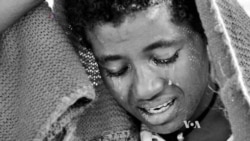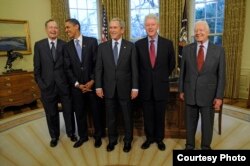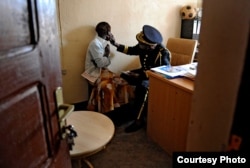This month's murder of French photographer Camille Lepage in Central African Republic highlights the dangers of capturing the devastation of war on film.
But the risks have not stopped Mary F. Calvert from travelling the world, documenting stories she believes are under-reported.
The award-winning American photojournalist believes her most meaningful images are the ones she has taken of women in the most difficult moments of their lives.
Her assignments over 25 years have taken her all over the globe to capture images as diverse as intimate portraits of U.S. presidents to colorful images of monks in Bhutan. But an experience in Ethiopia marked a turning point in her career.
Triage journalism
She was doing a story on women with obstetric fistula. The condition is caused by prolonged obstructed labor, which creates a hole between the vagina and rectum or bladder leaving a woman incontinent of urine or feces or both.
Meeting those women, Calvert says, "changed everything for me.”
“These were women that had this terrible condition where they were incontinent, they had to live away from their families, nobody wanted to be near them; they were shunned from society,” she said. “But if they made it to this hospital and they got a surgery that took 20-30 minutes and only cost about $400 dollars American, it gave them their lives back."
She recalls thinking that telling these stories was what she was meant to do. So Calvert embarked on what she refers to as “triage journalism,” giving priority to underreported stories of women in crisis, from opium addiction in Afghanistan to sexual violence in Congo.
“Every news story I read, every clip I saw on the Internet, it was as if I could hear these women screaming from the bottom of a very deep well and I knew that I had to do the story,” she said.
Rape as tool of war
Calvert notes that it is more dangerous to be a woman than a soldier in Democratic Republic of Congo. "There is a terrible epidemic of rape. Rape is used as a tool of war. It’s cheaper than bullets and it’s guaranteed to destroy every community it’s unleashed in.”
Calvert describes a meeting she witnessed between a young rape victim and the head of the sexual violence victim’s department of the Bukavu police department.
"She started interviewing her about how she’d been raped in her neighborhood. And my hands were just shaking because I thought this is an amazing thing to be witnessing."
And then there was a knock at the door.
"A police officer brought in the perpetrator," she said. "And that’s one of those situations that comes along very rarely for a photographer.”
Calvert says that while DRC was a frightening place to be, she was inspired by the people she met there.
“I met many, many people who had had terrible things done to them and yet they got up every day and they went on with their lives,” she said. “It really changed the way I look at everything that I have in the U.S. and how fortunate we are. I have to value that more."
Award-winning work
Calvert has twice been a Pulitzer Prize finalist and the recipient of dozens of other awards, including the Robert F. Kennedy Award in International Photography.
That prestigious prize honored her for her photos from India, documenting the prevalent practice of doctors aborting female fetuses because of a cultural preference for male babies.
“In the last 20 years they’ve lost about ten million girls to sex selection,” she said. “You know there’s an old Punjabi saying that says, ‘Having a daughter is like watering your neighbor’s garden,’ and that really struck me at a very deep level.”
Calvert is aware of the risks she’s taking every time she ventures into hostile territory with her camera.
“I have been in some dangerous situations from Afghanistan to Congo," she said, "and I always tell myself ‘I am going into this situation for a few hours, a few days, maybe four or five weeks, and the people I’m photographing live here. This is their every day.’ And I tell myself ‘You can handle it for a little while because they have to handle it for their whole life.’”
Calvert hopes the images she has captured of women in crisis will help raise awareness about their plight wherever in the world they may be.
But the risks have not stopped Mary F. Calvert from travelling the world, documenting stories she believes are under-reported.
The award-winning American photojournalist believes her most meaningful images are the ones she has taken of women in the most difficult moments of their lives.
Her assignments over 25 years have taken her all over the globe to capture images as diverse as intimate portraits of U.S. presidents to colorful images of monks in Bhutan. But an experience in Ethiopia marked a turning point in her career.
Triage journalism
She was doing a story on women with obstetric fistula. The condition is caused by prolonged obstructed labor, which creates a hole between the vagina and rectum or bladder leaving a woman incontinent of urine or feces or both.
Meeting those women, Calvert says, "changed everything for me.”
“These were women that had this terrible condition where they were incontinent, they had to live away from their families, nobody wanted to be near them; they were shunned from society,” she said. “But if they made it to this hospital and they got a surgery that took 20-30 minutes and only cost about $400 dollars American, it gave them their lives back."
She recalls thinking that telling these stories was what she was meant to do. So Calvert embarked on what she refers to as “triage journalism,” giving priority to underreported stories of women in crisis, from opium addiction in Afghanistan to sexual violence in Congo.
“Every news story I read, every clip I saw on the Internet, it was as if I could hear these women screaming from the bottom of a very deep well and I knew that I had to do the story,” she said.
Rape as tool of war
Calvert notes that it is more dangerous to be a woman than a soldier in Democratic Republic of Congo. "There is a terrible epidemic of rape. Rape is used as a tool of war. It’s cheaper than bullets and it’s guaranteed to destroy every community it’s unleashed in.”
Calvert describes a meeting she witnessed between a young rape victim and the head of the sexual violence victim’s department of the Bukavu police department.
"She started interviewing her about how she’d been raped in her neighborhood. And my hands were just shaking because I thought this is an amazing thing to be witnessing."
And then there was a knock at the door.
"A police officer brought in the perpetrator," she said. "And that’s one of those situations that comes along very rarely for a photographer.”
Calvert says that while DRC was a frightening place to be, she was inspired by the people she met there.
“I met many, many people who had had terrible things done to them and yet they got up every day and they went on with their lives,” she said. “It really changed the way I look at everything that I have in the U.S. and how fortunate we are. I have to value that more."
Award-winning work
Calvert has twice been a Pulitzer Prize finalist and the recipient of dozens of other awards, including the Robert F. Kennedy Award in International Photography.
That prestigious prize honored her for her photos from India, documenting the prevalent practice of doctors aborting female fetuses because of a cultural preference for male babies.
“In the last 20 years they’ve lost about ten million girls to sex selection,” she said. “You know there’s an old Punjabi saying that says, ‘Having a daughter is like watering your neighbor’s garden,’ and that really struck me at a very deep level.”
Calvert is aware of the risks she’s taking every time she ventures into hostile territory with her camera.
“I have been in some dangerous situations from Afghanistan to Congo," she said, "and I always tell myself ‘I am going into this situation for a few hours, a few days, maybe four or five weeks, and the people I’m photographing live here. This is their every day.’ And I tell myself ‘You can handle it for a little while because they have to handle it for their whole life.’”
Calvert hopes the images she has captured of women in crisis will help raise awareness about their plight wherever in the world they may be.











